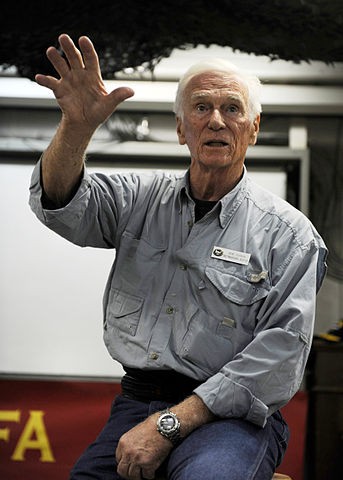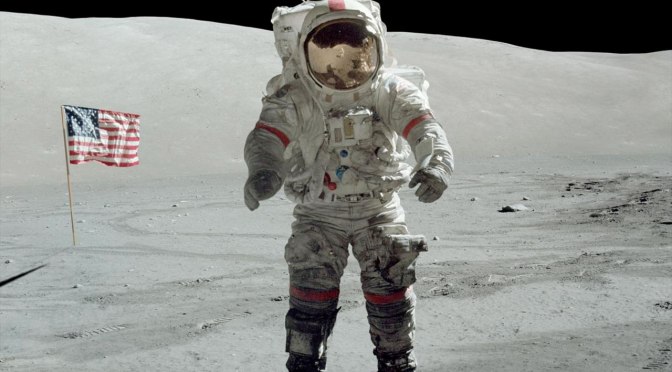EUGENE Cernan, the last man on the moon, passed away in January.
The death of this American hero, Commander of the Apollo 17 mission, came as sad news to anyone aware of his incredible achievements, especially those with a passion for space history.
So it is no wonder an audience packed into The British Interplanetary Society (BIS) Headquarters in London to celebrate his life by hearing from a man who got to know Cernan well in the final years of his life.
Director Mark Craig, who has made a documentary chronicling Cernan’s life titled The Last Man on the Moon, spoke for nearly 100 minutes on his relationship and experiences with the great astronaut.
Craig’s film, released in cinemas in 2014, is a brilliant personal study that even the most novice space fan (like myself) can be enthralled and moved by.
It was a project Craig set his sights on after reading Cernan’s autobiography back in 2007. He revealed the book had awoken a passion for space that he possessed as a child of the 1960’s – a time when the moon was an exciting new frontier.
Space missions were frequent and televised. Space technology was rapidly evolving and astronauts were considered by many as demigods.

Craig soon discovered a film based around Cernan would not be the easiest to get off the ground. Years of frustrating negotiations with lawyers and the usual struggle of finding financial backers left him exasperated. Cernan also needed to be sure he could trust this English filmmaker with his legacy.
Fearing the project may never get approval, Craig emailed Cernan with an emotional plea about the film’s potential to inspire future generations of space enthusiast.
He also received an unexpected endorsement from Cernan’s friend – and Hollywood megastar – Harrison Ford. The actor supposedly gave the astronaut some sound advice: ‘it is not about you, it is about your story.’
The sentiment was enough to get Cernan on-board who then invited Craig and producer Gareth Dodds (a fellow Brit) to his ranch in Houston, Texas.
Here, the two Brits were exposed to Cernan’s lifestyle – the classic Texan cowboy attire, the rodeos and the cattle, admittedly kept for show more than anything else. Inside his home were artefacts from Cernan’s varied career, including his time as an aviator. Alongside the astronaut paraphernalia was a burnt helmet from a near fatal helicopter crash.

Surprisingly, it was in Cernan’s garage that the duo made their most important discovery. A treasure trove of family photos, professional photos and rolls of home movie film which Craig described as ‘gold dust’ for a documentary filmmaker.
He is right. This collection gives the film an incredible life that many stock-footage-heavy documentaries simply cannot capture. It also allowed Craig to give the film a distinct personal quality.
The Last Man on the Moon narrows in on Cernan as a person without getting bogged down in heavy science – an approach which Craig says favours ‘heart over head’.
As part of this personal tone, they decided to take Cernan back to important locations in his life – such as a launchpad , his home in Nassau Bay, an aircraft carrier and Arlington Cemetery. Cernan, shown in the documentary to be a great storyteller and charismatic individual, then evokes his memories of these places in a way which would not have been possible had he been interviewed from the comfort of his ranch.
He was also given the courtesy of cinematographer Tim Cragg’s powerful camera (a focal lens of 18-290). Cragg and the crew set up the camera at a distance to allow Cernan plenty of space to reflect and act naturally . This non-intrusive approach is something that Craig believes gets interviewees to speak more freely and openly than being followed around by an in-your-face camera.

For those in attendance at the BIS, Craig showed a few clips that did not make the 97 minute final cut for the theatrical release (the original cut was over three hours).
One clip that ended up on the cutting floor featured an amusing exchange between Cernan and Dick Gordon who were in competition to command the Apollo 17 crew. It had the audience in stitches and hungry for more.
For the time being, The Last Man on the Moon remains on UK Netflix until its licence runs out next month. Terrestrial television will then likely be its next destination.
But what is next up for Craig?
He revealed he wants to make a film about the tragic Apollo One incident with a similar personal touch. The rapport he built with Martha Chaffee – a widow of one of the three Apollo One astronauts and former neighbour of Cernan – during the shooting of The Last Man on the Moon makes such a project feasible.
Let us hope he can make it happen. It would be fitting tribute to the three who lost their lives so young: Lieutenant Commander Roger Chaffee, aged 31, Air Force Lieutenant Colonel Gus Grissom, 39, and Air Force Lieutenant Colonel Ed White, 35.
On the evidence of The Last Man on the Moon, Craig would see to that.
Check out: The British Interplanetary Society
The Last Man on the Moon (available on Blu-Ray)
Thank you for reading. Please like, share and comment!
Also read: Raw Q&A with director Julia Ducournau

2 thoughts on “Director Mark Craig talks about the last man on the moon”